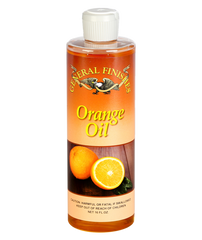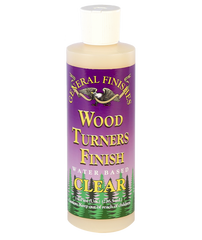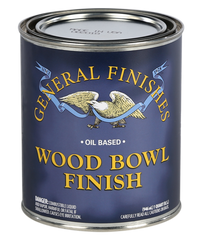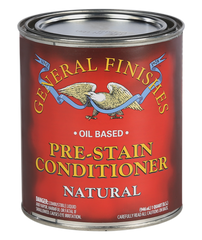Product Description
Winner of Fine Woodworking's "Best Overall Choice Award," High Performance Topcoat was voted as the hardest, most durable consumer polyurethane topcoat.
Instructions
Preparation for Raw Wood or Raw Wood Projects That Are to be Stained
- Sanding Schedule: 120-grit followed by 150- or 220-grit sandpaper.
- Remove dust with a vacuum, compressed air, an oil-free tack cloth or a water-dampened rag.
- Let dry completely before applying GF product.
- Do not over-sand with fine-grit sandpapers; this will close and seal the wood grain, preventing ideal color absorption.
- Do NOT use steel wool with water-based finishes; the particles will get trapped in the finish and rust.
Preparation for Projects with an Existing Finish (Sealed Surface)
For high-use areas with heavy grime build-up and oil from hands, give your project a deeper cleaning.
- Scuff clean with a Scotch Brite pad and a 50:50 mix of denatured alcohol and water. Dry 1-2 hours. Avoid cleaning with products containing phosphates (salt), which can linger in the substrate and produce a white haze. If your project requires a deeper cleaning, see Power Prep Cleaning Highly Used Existing Finishes below.
- Sand lightly with a fine-grade (220-320) foam sanding pad.
- Remove dust with a vacuum, compressed air, an oil-free tack cloth or a water-dampened rag.
- Let dry completely before applying General Finishes product.
Power Prep Cleaning Highly Used Existing Finishes
For high-use areas such as kitchen cabinets or table tops with heavy grime build-up and oil from hands, give your project a "Power" clean.
- Scrub clean with a detergent, such as Spic and Span or Dawn, using a Scotch Brite pad.
- Rinse well with water.
- Scrub clean with a Scotch Brite pad and a 50:50 mix of denatured alcohol and water. Dry 1-2 hours.
- Sand lightly with a fine-grade (220-320) foam sanding pad.
- Remove dust with a vacuum, compressed air, an oil-free tack cloth or a water-dampened rag.
- Let dry completely before applying General Finishes product.
Alternative Cleaning Solutions For Existing Finishes (Not as aggressive or effective as denatured alcohol; requires rinsing.)
- 50:50 mix of bleach and water
- 50:50 mix of vinegar and water
- Mineral spirits can be used when working with water-based products, but only if the surface is thoroughly rinsed and allowed to dry for 72 hours.
- If you use with products containing phosphates (salt), which can linger in the substrate and produce a white haze, be sure to rinse thoroughly.
General Finishes High Performance Water Based Topcoat Application Steps
- Stir topcoat to reincorporate solids that have settled to the bottom of the can before and throughout the application process.
- If desired, thin with up to 15% distilled water or General Finishes Extender. Start by adding 5% in increments until you reach the desired consistency. GF Extender will improve flow and leveling and increase open time, which is helpful in dry climates.
- Apply 3 coats of High Performance. More coats will not improve durability.
- Hand application: Apply a liberal amount of product using a synthetic bristle brush, foam brush, pad applicator, or roller such as Whizz or AllPro Velour brand. Avoid pressure and excessive back brushing. Brush along the wood grain using smooth, even strokes with light lap marks. Let lap marks dry - they WILL tighten down.
- Spray application: Before spraying, strain topcoat through a fine-mesh filter. Spray wet films at 3-5-mil thickness. HVLP: 1.1mm-1.3mm spray tip, medium air cap. Verify tip sizes with your equipment supplier. Keep your gun at a 90° angle, 6-8" from the surface. On large, flat areas, use wet, even patterns 6-8" wide. For narrow surfaces, reduce the fan pattern to 2-3" wide to reduce overspray. Overlap each pass 25% to conceal lines. Wear a full filter respirator (NIOSH/MSHA-approved) and work in a ventilated space.
- Face frames and drawers on cabinets: High Performance can be successfully applied by hand to cabinet face frames or edges with a brush, pad or small, cabinet-specific roller such as Whizz or AllPro Velour brand.
- If a faster build is desired over raw wood, use General Finishes Sanding Sealer for the first coat, followed by 2 coats of High Performance Topcoat.
- Dry 2+ hours between coats in ideal conditions: 70°F 20°C; 50-70% humidity. Be sure to allow adequate dry time. You can tell if a water-based finish is dry if it forms a powder when lightly sanded with a fine-grade (220-320) foam sanding pad. If in doubt, wait longer. Rushing the dry time can cause "blush," which is clouding in the finish due to moisture trapped between the layers. Increase dry time if:
- Humidity is over 80%
- 3+ coats are applied
- Thick coats are applied
- Applying over an existing sealed finish
- Applying over products from other brands
- Layering General Finishes water- and oil-based products:
- Water over oil: Let oil-based products dry 72+hr before applying water-based products
- Oil over water: Let water-based products dry 24+hr before applying oil-based products
-
To accelerate dry time in humid conditions, add General Finishes Accelerator and work in a space with good ventilation and air movement. If you decide to re-coat before the recommended time, test dryness.
- Finish sand between coats with a fine-grade (220-320) foam sanding pad to improve smoothness and adhesion.
- Remove dust with a vacuum, compressed air, an oil-free tack cloth or a water-dampened rag.
Cure Time
Water-based finishes cure and harden for full use after 21 days in ideal conditions. Avoid placing heavy objects on surfaces that have not completely cured. Treat gently, and do not clean with commercial products during the curing period.
Tips to prevent streaking during hand-application:
- Use a semi-gloss or gloss sheen with little to no flatting agents. The more flatting agents, the more likely a topcoat will streak when applied.
- To avoid streaking with the flatter sheens, apply a liberal amount of product and avoid using pressure and back-brushing. Wipe along the wood grain using smooth, even strokes. For large surfaces, apply topcoat with a large applicator, such as a paint pad.
- Remove any streaks that occur by buffing with fine-grade (220-320) sanding pad, or sanding well and re-coating.
- For the smoothest result, apply with a spray gun.
Mixing Sheens
You mix can High Performance Topcoat sheens to adjust your sheen. For example, you can mix High Performace Flat and High Performance Gloss to obtain a different sheen.
Warning: Do not use water-based products with Linseed Oils or Danish Oils.
SDS
Flat
Satin
SemiGloss
Gloss
Key Features
N/A
Guarantee
N/A
| Spec 1 | Spec 2 |
|---|





